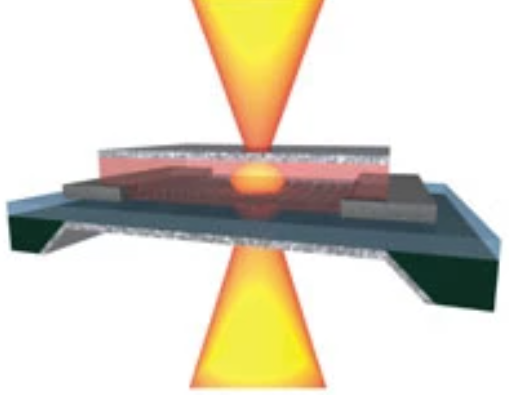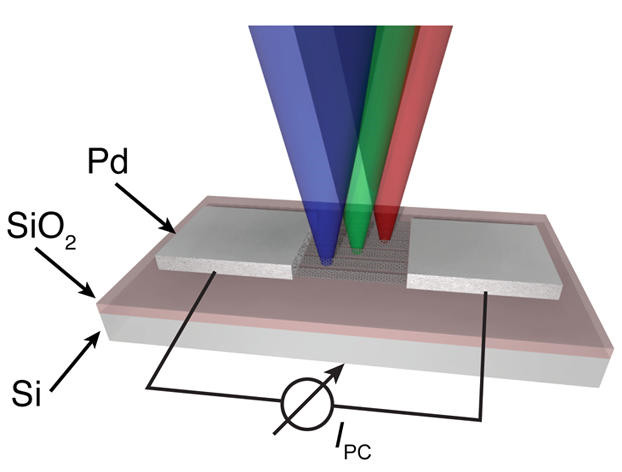Research - Nanoscale light emission and detection
Photons are the fastest carriers of information possible. For this reason a large proportion of mid- and long-distance electrical communication connections have been replaced by fiber optics in the last decades. The next evolutionary step will be the replacement of short-distance electrical connections by optical waveguides, to enhance on-chip data transfer rates, for example between processor and memory. We are currently working on the development of electrically-driven nanoscale light emitters and detectors and their integration into waveguide/device structures.
 A promising material for optoelectronics is single-walled carbon nanotubes, which can be stimulated electrically to emit light. Depending on the type of nanotubes (metallic or semiconducting) and the mode of operation, the emission can be narrowband (electroluminescence) or broadband (incandescence). We use electric-field assisted placement (dielectrophoresis) of solution-processed carbon nanotubes into lithographically pre-defined structures. Using this approach we can demonstrate efficient coupling of light emitted from an electrically-stimulated carbon nanotube into photonic circuits [Advanced Materials 26 (2014) 3465]. We are also exploring electroluminescence from nanotube-molecule-nanotube contacts [Nature Nanotechnology 5 (2010) 863].
A promising material for optoelectronics is single-walled carbon nanotubes, which can be stimulated electrically to emit light. Depending on the type of nanotubes (metallic or semiconducting) and the mode of operation, the emission can be narrowband (electroluminescence) or broadband (incandescence). We use electric-field assisted placement (dielectrophoresis) of solution-processed carbon nanotubes into lithographically pre-defined structures. Using this approach we can demonstrate efficient coupling of light emitted from an electrically-stimulated carbon nanotube into photonic circuits [Advanced Materials 26 (2014) 3465]. We are also exploring electroluminescence from nanotube-molecule-nanotube contacts [Nature Nanotechnology 5 (2010) 863].

 Complementary to light emission studies we are exploring the potential of carbon nanotubes and graphene for nanoscale light detection. Depending on the type of nanotube, photocurrents are generated in a narrow or in a wide wavelength range, and are hence envisioned as nanoscale on-chip waveguide integrated transducers. We are exploring the photocurrent response of solution-processed carbon nanotubes [ACS Nano 8 (2014) 9324], of graphene [Nature Communications 3 (2012) 906] and of nanocrystalline graphene [Nanotechnology (2015)]. Furthermore we are studying the photoresponse of nanotube-molecule and graphene-molecule hybrid structures.
Complementary to light emission studies we are exploring the potential of carbon nanotubes and graphene for nanoscale light detection. Depending on the type of nanotube, photocurrents are generated in a narrow or in a wide wavelength range, and are hence envisioned as nanoscale on-chip waveguide integrated transducers. We are exploring the photocurrent response of solution-processed carbon nanotubes [ACS Nano 8 (2014) 9324], of graphene [Nature Communications 3 (2012) 906] and of nanocrystalline graphene [Nanotechnology (2015)]. Furthermore we are studying the photoresponse of nanotube-molecule and graphene-molecule hybrid structures.
We greatly acknowledge financial support by the VolkswagenStiftung and the Helmholtz Association.
